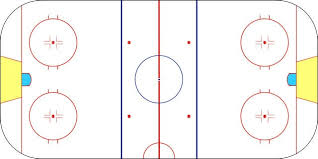Have you ever thought about why some sections of the rink are off-limits to goalkeepers when it comes to playing the puck? Fundamentally, everything boils down to the trapezoid rule.
Here you will discover the reasons behind this regulation and how it affects hockey in this blog.
What is Meant By the Trapezoid Rule?
In ice hockey, the Trapezoid Rule places restrictions and limits on the area in which goalies are allowed to play the puck.
It restricts goalies from handling the puck outside of a defined trapezoid-shaped area behind their net.
The rule came into existence to enhance the flow of the game and to prevent goalkeepers from excessively slowing down play.
Why Was the Trapezoid Rule Implemented?
- Preventing Delay of Game: When goalkeepers can handle the puck anywhere on the ice, it can cause delays because they will frequently play the puck far from their net in an attempt to deliberately stall the game. To lessen this delay and keep the game going forward, the Trapezoid Rule was established.
- Promoting Offensive Opportunities: If you stop goalies from playing puck only within the trapezoid gives opposing teams a great opportunity to forecheck aggressively and create scoring chances. This adds thrill to the game and encourages offensive play.
- Maintaining Fairness: Maintaining an even playing field is facilitated by restricting the goalkeeper’s puck-handling skills outside of the trapezoid. It keeps goalies who are perfectly skilled at controlling the puck from having an unfair benefit over their rivals.
What is the Impact on the Game?
The Trapezoid Rule has had a significant impact on the dynamics of hockey games:
- Faster Pace: The game is moving more rapidly now that goalkeepers are not free to move around and play the puck, which gives fans more thrill and excitement.
- Increased Offensive Pressure: Now that the goalie is under more pressure to recover the puck, opposing teams have more opportunities to score.
- Strategic Adjustments: Innovative strategies and approaches to the game have resulted from coaches and players having to modify their methods to fit under the constraints of the Trapezoid Rule.
Does The Puck Need To Cross The Goal Line All The Way?
To ensure accuracy in officiating, video replay technology is frequently employed to check close calls. This criterion highlights how crucial accuracy and precision are in deciding how a game will turn out.
A goal in ice hockey is scored when the puck crosses the goal line between the goalposts and under the crossbar.
This regulation guarantees precision in ascertaining the validity of a goal score. The goal is not given if any portion of the puck is still on or over the goal line.
Conclusion
To promote a faster-paced and more thrilling game of ice hockey, the Trapezoid Rule is important in contemporary ice hockey.
The rule guarantees fair play on the ice and promotes offensive chances by restricting goalies from playing the puck beyond a set area. Knowing this guideline improves our understanding of the sport’s subtle strategic aspects.
Read More: Unlocking the NHL Trapezoid Rule: The Hockey Trapezoid Rule


